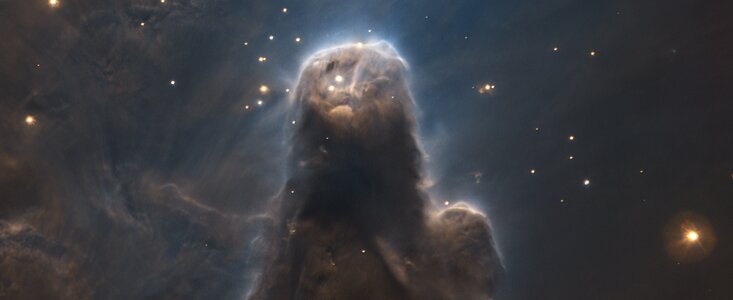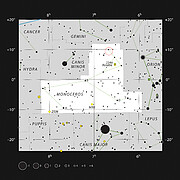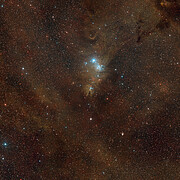Comunicato Stampa
L'ESO fotografa una meravigliosa fabbrica di stelle per celebrare 60 anni di collaborazione
10 Novembre 2022
Negli ultimi 60 anni l'ESO (European Southern Observatory) ha consentito agli scienziati di tutto il mondo di scoprire i segreti dell'Universo. Celebriamo questo traguardo presentandovi la nuova spettacolare immagine di una fabbrica di stelle, la Nebulosa Cono, scattata con il VLT (Very Large Telescope) dell'ESO.
Il 5 ottobre 1962 cinque paesi hanno firmato la convenzione per creare l'ESO. Ora, sei decenni dopo e sostenuto da 16 tra stati membri e partner strategici, l'ESO riunisce scienziati e ingegneri di tutto il mondo per sviluppare e gestire in Cile osservatori da terra all'avanguardia che permettono di ottenere scoperte astronomiche rivoluzionarie.
In occasione del 60° anniversario dell'ESO, pubblichiamo questa nuova straordinaria immagine della Nebulosa Cono, catturata all'inizio di quest'anno con uno dei telescopi dell'ESO e selezionata dallo staff dell'ESO. L'immagine fa parte di una campagna che celebra il 60° anniversario dell'ESO e si svolgerà alla fine del 2022, sia sui canali social con l'hashtag #ESO60years, sia con eventi locali negli Stati membri dell'ESO e in altri paesi.
Nella nuova immagine, vediamo al centro della scena il pilastro della Nebulosa Cono, lungo sette anni luce, che fa parte della più ampia regione di formazione stellare NGC 2264 ed è stata scoperta alla fine del XVIII secolo dall'astronomo William Herschel. Troviamo questa nebulosa a forma di corno nella costellazione del Monoceros (l'unicorno), un nome sorprendentemente appropriato.
Ubicata a meno di 2500 anni luce di distanza da noi, la Nebulosa Cono è relativamente vicina alla Terra, il che ne fa un oggetto molto ben studiato. Ma questa veduta è più drammatica di qualsiasi altra ottenuta prima, poiché mostra l'aspetto scuro e impenetrabile della nebulosa in un modo che la fa assomigliare a una creatura mitologica.
La Nebulosa Cono è un perfetto esempio delle forme simili a pilastri che si sviluppano nelle gigantesche nubi di gas molecolare freddo e polvere, note per la creazione di nuove stelle. Questo tipo di pilastro si forma quando le stelle blu brillanti e massicce di nuova formazione emettono venti stellari e intense radiazioni ultraviolette che spazzano via il materiale dalle loro vicinanze. Mentre il materiale viene spinto via, il gas e la polvere più lontani dalle giovani stelle vengono compressi in forme dense, scure e alte simili a pilastri. Questo processo aiuta a creare l'oscura Nebulosa Cono, che punta lontano dalle stelle brillanti di NGC 2264.
In questa immagine, ottenuta con lo strumento FORS2 (FOcal Reducer and low dispersion Spectrograph 2) installato sul VLT dell'ESO in Cile, l'idrogeno gassoso è rappresentato in blu e lo zolfo gassoso in rosso. L'uso di questi filtri fa sì che le stelle che indicano la recente formazione stellare, che altrimenti sarebbero blu e molto luminose, appaiano quasi dorate, in contrasto con il cono scuro quasi come luminarie.
Questa immagine è solo un esempio delle numerose osservazioni sbalorditive e affascinanti che i telescopi dell'ESO hanno realizzato in 60 anni. Anche se questa è stata ottenuta a scopo divulgativo, quasi tutto il tempo dei telescopi dell'ESO è dedicato alle osservazioni scientifiche che ci hanno permesso di catturare la prima immagine di un esopianeta, di studiare il buco nero al centro della nostra Galassia e di trovare la prova che l'espansione del nostro Universo sta accelerando.
A partire da questi 60 anni di esperienza nello sviluppo, nella scoperta e nella cooperazione dell'astronomia, l'ESO continua ad aprire nuove strade per l'astronomia, la tecnologia e la collaborazione internazionale. Con le strutture attuali e il prossimo ELT (Extremely Large Telescope) dell'ESO, continueremo ad affrontare le più grandi domande dell'umanità sull'Universo e consentire scoperte inimmaginabili.
Ulteriori Informazioni
Questa immagine è stata prodotta nell'ambito programma Gemme Cosmiche dell'ESO, un'iniziativa di divulgazione pensata per produrre immagini di oggetti interessanti o anche solo piacevoli da vedere utilizzando i telescopi dell'ESO, a fini didattici e di divulgazione verso il pubblico. Il programma utilizza il tempo del telescopio che non è adatto per le osservazioni scientifiche. Tutti i dati raccolti potrebbero in ogni caso essere interessanti anche per scopi scientifici e sono perciò messi a disposizione degli astronomi attraverso l'archivio scientifico dell'ESO.
L'ESO (European Southern Observatory o Osservatorio Europeo Australe) consente agli scienziati di tutto il mondo di scoprire i segreti dell'Universo a beneficio di tutti. Progettiamo, costruiamo e gestiamo da terra osservatori di livello mondiale - che gli astronomi utilizzano per affrontare temi interessanti e diffondere il fascino dell'astronomia - e promuoviamo la collaborazione internazionale per l'astronomia. Fondato come organizzazione intergovernativa nel 1962, oggi l'ESO è sostenuto da 16 Stati membri (Austria, Belgio, Danimarca, Francia, Finlandia, Germania, Irlanda, Italia, Paesi Bassi, Polonia, Portogallo, Regno Unito, Repubblica Ceca, Spagna, Svezia e Svizzera), insieme con il paese che ospita l'ESO, il Cile, e l'Australia come partner strategico. Il quartier generale dell'ESO e il Planetario e Centro Visite Supernova dell'ESO si trovano vicino a Monaco, in Germania, mentre il deserto cileno di Atacama, un luogo meraviglioso con condizioni uniche per osservare il cielo, ospita i nostri telescopi. L'ESO gestisce tre siti osservativi: La Silla, Paranal e Chajnantor. Sul Paranal, l’ESO gestisce il VLT (Very Large Telescope) e il VLTI (Very Large Telescope Interferometer), così come telescopi per survey come VISTA. Sempre a Paranal l'ESO ospiterà e gestirà la schiera meridionale di telescopi di CTA, il Cherenkov Telescope Array Sud, il più grande e sensibile osservatorio di raggi gamma del mondo. Insieme con partner internazionali, l’ESO gestisce APEX e ALMA a Chajnantor, due strutture che osservano il cielo nella banda millimetrica e submillimetrica. A Cerro Armazones, vicino a Paranal, stiamo costruendo "il più grande occhio del mondo rivolto al cielo" - l'ELT (Extremely Large Telescope, che significa Telescopio Estremamente Grande) dell'ESO. Dai nostri uffici di Santiago, in Cile, sosteniamo le operazioni nel paese e collaboriamo con i nostri partner e la società cileni.
La traduzione dall'inglese dei comunicati stampa dell'ESO è un servizio dalla Rete di Divulgazione Scientifica dell'ESO (ESON: ESO Science Outreach Network) composta da ricercatori e divulgatori scientifici da tutti gli Stati Membri dell'ESO e altri paesi. Il nodo italiano della rete ESON è gestito da Anna Wolter.
Links
- Ulteriori informazioni sulla campagna per il 60o anniversario dell'ESO
- Fotografie del VLT
- Per i giornalisti: iscrivetevi per ricevere i nostri comunicati sotto embargo nella vostra lingua
- Per i ricercatori: avete una storia da raccontare? Inviateci il vostro articolo scientifico
Contatti
Juan Carlos Muñoz Mateos
ESO Media Officer
Garching bei München, Germany
Tel.: +49 89 3200 6176
E-mail: press@eso.org
Anna Wolter (press contact Italia)
Rete di divulgazione scientifica dell'ESO
e INAF-Osservatorio Astronomico di Brera
Milano, Italy
Tel.: +39 02 72320321
E-mail: eson-italy@eso.org
Sul Comunicato Stampa
| Comunicato Stampa N": | eso2215it |
| Nome: | Cone Nebula, NGC 2264 |
| Tipo: | Milky Way : Nebula : Type : Star Formation Milky Way : Nebula : Appearance : Emission : H II Region |
| Facility: | Very Large Telescope |
| Instruments: | FORS2 |




